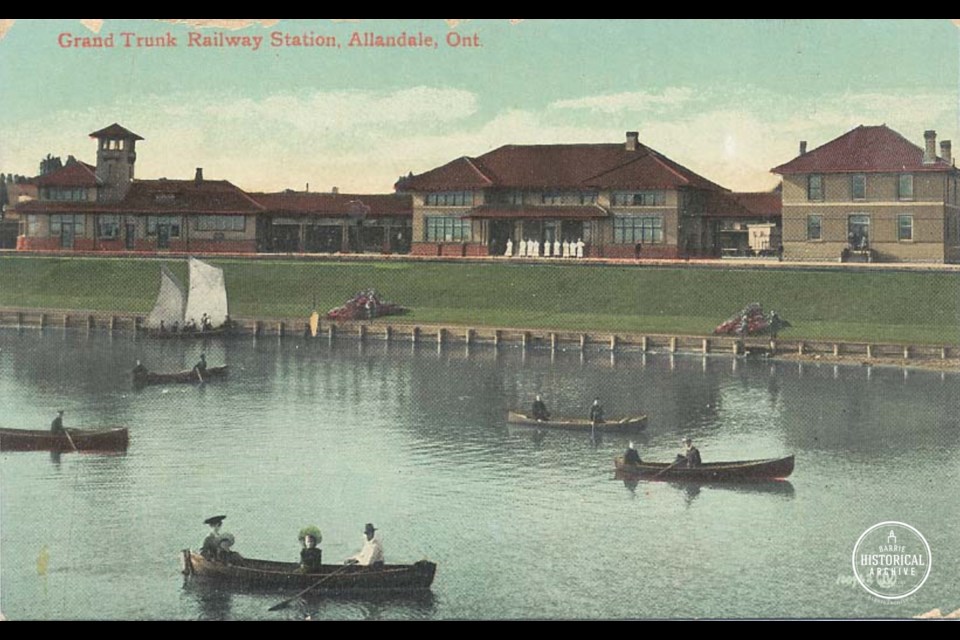This ongoing series from Barrie Historical Archive curator Deb Exel shows old photos from the collection and one from the present day.
Allandale Station Lands
It was all about the trains.
Allandale’s boom can be largely credited to the arrival of the railroad in 1853 when the Ontario, Simcoe and Huron Union Railroad (O.S.H.) reached its shores. It was the first of other railway companies such as the Toronto, Simcoe and Muskoka Junction Railway Company and the North Simcoe Railway that built lines into or close to Allandale.
The village of Allandale grew and flourished, over time adding jobs, housing, schools and commerce to support the exciting new industry and growing community. Travel to the north from Toronto and the movement of supplies and resources, such as timber, became easier and more efficient thanks to these railway lines and the trains chugging over them.
The south shore wasn’t always the beautiful park land it is today. It was a railway yard.
The first station, destroyed by fire in 1894, was located on the curve of a much cruder shoreline than nowadays. It was a hard-working area, designed for the increasingly busy and expanding infrastructure needed to support the railroad.
Buildings such as the Master Mechanics offices (what we call the Southshore Centre today), built in 1903, and to its east, the roundhouse, turntable and massive coal chute to fill the tenders, or coal cars of the trains, were all part of the railroad system.
When the O.S.H. became the Grand Trunk Railway, a new station was built in 1905, again following the curve of the bay. The Allandale station was all elegance and extravagance. Now, after a period of neglect, the gracious old train station is once again a stunning historical showpiece overlooking the bay, even if it's not accessible to the public.
The neighbourhood around the station lands evolved socially and commercially – The Railroad YMCA opened in 1907 and around the corner, on station land, the Allandale Lawn Bowling Club opened about 1910.
Business was brisk in downtown Allandale and Bothwell Corners (technically in Barrie, but right on the border) and especially the popular Webb Jewelers, where railroad men had their all-important pocket watches serviced.
The railroad drew people to the area for work and to settle. Many residents have an ancestral connection to the railroad — my own grandfather was an engineer and my father was briefly a fireman. The railway is part of many local family histories and legacies.
Yes, it was mostly the iron horse, the steam locomotives, that drove Allandale’s transformation from a small village to a bustling community. Our collective local history is full of moments and memories of passenger trains, freight trains, museum trains, Rocky Mountain trains, centennial trains, trains that launched special trips, celebration trains, and, sadly, the last trains to arrive and depart from Allandale’s station.
There’s another train, maybe not completely original in all its parts or in particularly great condition, but hugely symbolic of the great train era and its importance to the history of Barrie and Allandale: Engine 1531. Built in Quebec in 1910, the engine was in service until the 1950s. Abandoned for a period of time, Canadian National (CN) donated Engine 1531 to the City of Barrie in 1960. It was moved to Lakeshore Drive where it remained until 2008 when roadwork forced its relocation to the Simcoe County Museum.
The current fate of Engine 1531 is still to be determined. The City of Barrie is considering a permanent donation of the old engine to the museum, along with funding for its restoration. However, there are many Barrie and Allandale residents who feel strongly that Engine 1531 should be returned to the old station lands where it can enhance and complement the train station, and help tell the story of this important part of the historic Allandale neighbourhood.
In a recent deputation to city council, Cathy Colebatch, co-chair of the Allandale Neighbourhood Association (ANA) told council: “We have a potential opportunity to work collectively as a county, city and community together to bring a heritage vision to Allandale. This is an opportunity to elevate heritage tourism in Barrie.”
She went on to say: “Pre-COVID, during our last Celebrate Barrie event, we had a petition on the ANA table to Bring Back Engine 1531 and quickly had over 300 signatures. People were excited to talk trains both locomotive and GO trains. In fact, we have handed out over 1300 paper trains to the children over the years. Engine 1531 is an asset to the city of Barrie and could be a valuable asset to Tourism Barrie.”
Should Engine 1531 manage to find a home in Allandale then residents, along with visitors to Barrie, could enjoy this incredible historical artifact in a truly remarkable and significant heritage setting.


